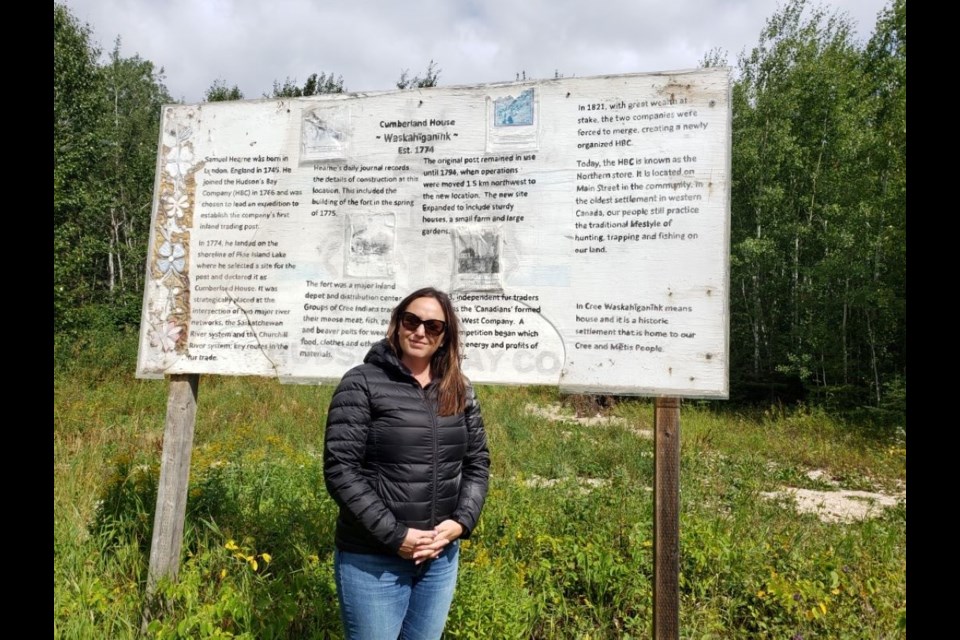SASKATOON – In the heart of Cumberland House, Sask., a groundbreaking digital heritage project will build connections between Indigenous communities, researchers, and institutions.
Driven by the vision of Cumberland House residents and led by Dr. Allyson Stevenson (PhD), assistant professor in the Department of Indigenous Studies at the University of Saskatchewan (USask) and Gabriel Dumont Institute Chair in Métis Studies, this unique research project aims to grow dynamic partnerships with galleries, libraries, archives, and museums across the Prairies to preserve and reclaim cultural heritage.
Cumberland House is an island situated in the Saskatchewan River Delta area and home to the Cumberland House Cree Nation, the Northern Village of Cumberland House, as well as Eastern Region 1 Métis Nation-Saskatchewan. It is also home to some of the most amazing thinkers, artisans, local historians and knowledge keepers in the province, according to Stevenson.
The community of Cumberland House is deeply invested in preserving their distinct Swampy Cree Métis heritage.
“The Cumberland House Museum Committee has been very active in redeveloping their local museum and creating a museum space to showcase the local artists’ beadwork, embroidery and birch bark items, as well as historically and culturally significant people and places,” said Stevenson. “As a distinctive Cree Métis northern community in the Saskatchewan River Delta, Cumberland House is ecologically and culturally significant. It is an honour to have the opportunity to work alongside the Museum Committee and the community.”
Born and raised in Saskatchewan, Stevenson’s personal and academic life is rooted in the province. An alumna of USask, her work as a historian has focused on Indigenous and Métis histories of the Prairies, including the impact of community-based resistance efforts led by Indigenous women.
Stevenson is particularly interested in decolonizing history, a passion she has harnessed for this project.
“Academic writing on the plains and Prairies is often written by outsiders that don’t necessarily understand specific social and cultural contexts of Indigenous communities,” said Stevenson.
Building a collaborative digital framework that will support Indigenous communities in directing and managing their cultural collections and engaging in new historical research is Stevenson’s inspiration.
“Through ethical and reciprocal collaboration, Indigenous community members, researchers, students, partner institutions and knowledge leaders plan to develop an Indigenous-directed digital heritage project for the community and generate new research in Indigenous public history, community-driven collaboration, and decolonial museum studies,” said Stevenson.
Digital methods have been increasingly incorporated into history projects, allowing communities and researchers to preserve, access, and share important materials and historical data. Digital heritage projects can ensure that a community can safeguard their cultural heritage for future generations.
Historic items that will be included in the digital archive include fur trade records that contain Cree names and other ancestral information Cree names, historic photos and videos taken by visitors or researchers, treaty documents, letters and correspondence of leaders through the years, as well as maps, journals and images of beadwork held by the museum. Cree oral histories and videos of community events can also be housed in the digital archive for students to access, and as a resource for educators to develop language revitalization projects.
The project harnesses its collaborative spirit by bringing in and working with many partners from all over the province. This includes nine organizations and institutions, including USask Digital Humanities Centre and University Archives and Special Collections, and nearly a dozen collaborators across Saskatchewan.
Stevenson’s project was recently awarded just under $200,000 over three years from the Social Sciences and Humanities Research Council (SSHRC). Stevenson and her collaborators are hopeful that this project may generate a museum tool kit and provide useful direction for other communities who are looking to establish similar historical projects or integrate historical materials back into their communities.
— Submitted by USask Media Relations




